The Attack on Pearl Harbor… Great Headlines Speak For Themselves…
February 18, 2016 by GuyHeilenman · Leave a Comment
The best headlines need no commentary. Such is the case with the HONOLULU STAR BULLETIN – 1st Extra! printed on December 7, 1941:
The Last Surviving Veterans Who Served at Pearl Harbor…
October 22, 2015 by GuyHeilenman · Leave a Comment
Collecting World War II era newspapers covering significant events continues to be popular among collectors, even though the number of WWII veterans continues to decline. Authentic issues of the Honolulu Star-Bulletin reporting the Pearl Harbor tragedy certainly stand above them all. It is with this in mind we are pleased to post the following article compliments of Francisco Mesa.
The Last Surviving Veterans Who Served at Pearl Harbor
As the years roll by, the list of surviving US veterans of WWII who served at Pearl Harbor when the Japanese Navy attacked the US Navy’s Pacific Fleet inevitably becomes shorter. And with the Pearl Harbor survivors well past their late 80s and some passing even the ripe-old century mark, their numbers are dwindling rapidly all over the US. Last year, just about 2,000 survivors were thought to be around, still.
National Pearl Harbor Remembrance Day
On December 7, 2014, the US President Barrack Obama designated December 7 as the National Pearl Harbor Remembrance Day. Four veterans of the remaining 9 USS Arizona survivors gathered at the Pearl Harbor Visitor Center on December 7, 2014, for a meeting of USS Arizona survivors. The veterans were greeted by music and military salutes from the US Navy Band. Later, they viewed a live feed of an underwater dive beside USS Arizona’s sunken hull that still holds over 900 bodies. For the veterans, each return to Pearl Harbor brings back intense and, sometimes, painful memories.
USS Arizona Reunion Association’s Last Gathering at Hawaii
Although it was the last formal survivor gathering of the erstwhile USS Arizona Reunion Association at Hawaii, the veterans said they still intend to get together—if not in Hawaii, somewhere in the US. Louis Conter, 93, felt he still had some time, and he’d come back to the Pearl Harbor Visitor Center regardless of who else makes it.
Donald Stratton, USS Arizona Survivor
Donald Stratton, 92, of Colorado is another USS Arizona survivor. Don Stratton had been manning the Anti-Aircraft gun batteries. He remained at his battle station on the ship’s port side until the last possible moment. He endured 65 percent burns and a one-year hospitalization. Stratton was medically discharged from the US Navy but re-enlisted a year later. He said that the good Lord saved a precious few from the USS Arizona.
John Anderson, USS Arizona Survivor
John Anderson, 97, was ordered off the USS Arizona, but he wasn’t willing to leave behind his twin brother, Delbert. Although Anderson was forced into a boat and packed off to the safer Ford Island, he returned in an empty boat and rescued three shipmates. Sadly, he didn’t find his brother. Anderson recalled that he had just attended church services that day and had been heading to breakfast when someone warned that the Japanese planes were coming.
Anderson Recalls the Harrowing Experience
Anderson remembers lying in a bomb-blast crater on Ford Island after the surprise attack. He had picked up a rifle and two bandoliers of ammunition and started firing at Japanese aircraft. Anderson had hunkered there through that night with another sailor. In the morning, a passing Marine patrol informed him that survivors of the USS Arizona had to gather at the dock nearby to facilitate a head count. Anderson remembers everyone he saw having rags around their heads. He clearly recalls bandages covered their arms and their skin had been scorched, and their hair had been burned off.
Lauren Bruner, USS Arizona Survivor
Lauren Bruner, 94, had been alongside Don Stratton manning his battle station. There were four others as well. Bruner had escaped from the fiery, sinking battleship by shimmying across a rope that dangled 60 feet above Pearl Harbor’s waters. Bruner had been standing just 70 feet from the spot the torpedo bomb had exploded at the USS Arizona’s forward magazine. He suffered almost 75 percent burns. But that didn’t deter him. Bruner and his comrades were intent on fighting back. There was only one thing that hampered them … they just had to survive the next few moments. So, after catching the attention of one sailor aboard the warship moored alongside their own, a rope stretching almost 100 feet was thrown across.
The Sailors’ Great Escape from the Burning USS Arizona
All the 6 men made the painful—all of them had suffered serious burns—hand-over-hand escape. They had dangled 60 feet in the air as huge flames rising from the oily harbor had burned their skin even more. Bruner had been the second last to leave USS Arizona. Alvin Dvorak, the last one to escape over the rope, had been the one that caught the attention of the sailor on the USS Vestal. Unfortunately, Dvorak succumbed after spending 17 days in the hospital. He had suffered 84 percent burns. Lauren Bruner considers Alvin Dvorak to be the true hero of their great escape. Bruner spent the next seven months in the hospital and returned to the Pacific theater.
Conclusion
Although the survivors of Pearl Harbor are in their early or mid 90s, they can recall the Japanese sneak attack vividly. Many of the survivors fondly hope to live long enough to attend the 75th anniversary of the Pearl Harbor strike in Hawaii on December 7, 2016.
If you are ever visit Hawaii, there are several Pearl Harbor tours that range from just a couple hours to a full day. There are still droplets of oil coming out of the sunken battleship USS Arizona. Also, there are hundreds of people still entombed within the sunken battleship. It is said that the droplets of oil represent the crying of the fallen men and women. And when the droplets of oil stop, the crying will stop.
© Francisco Meza
The reprint issues of the “Honolulu Star-Bulletin” Pearl Harbor issue…
May 14, 2012 by TimHughes · 30 Comments
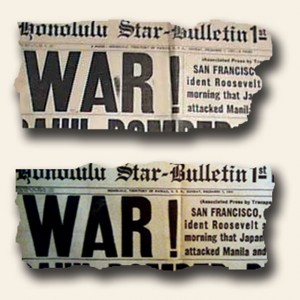 If there is a second in line for the most common phone call or email about a newspaper which turns out to be a reprint, it would be the December 7, 1941 of the “Honolulu Star-Bulletin – 1st Extra“.
If there is a second in line for the most common phone call or email about a newspaper which turns out to be a reprint, it would be the December 7, 1941 of the “Honolulu Star-Bulletin – 1st Extra“.
The genuine issue is arguably the best newspaper to have reporting the historic bombing of Pearl Harbor, being a dramatic headline, from the day it happened, and from where it happened. And consequently those conditions make it ripe for creating a reprint edition. From what I understand the reprints are still available at the souvenir shop at the Pearl Harbor memorial.
There are a couple of tell-tale indicators which are easily observed:
* The genuine issue has an ink smear between the “A” and “R” in the huge “WAR ! ” in the headline.
* The reprint edition does not have the ink smear, it having been “cleaned up” to make for a better appearance.
* The genuine “1st Extra” is 8 pages and does not have the “2nd Extra” nor the “3rd Extra” within, as they were separate, stand-alone edition printed later in the day. The reprint editions typically have one of both of the later editions on pages 3 and/or 5.
* At least one of the reprint edition has the front page of the “Honolulu Advertiser” newspaper on page 3. Obviously a competing newspaper’s front page would not be found within a genuine issue of the “Star-Bulletin”.
As if the above are not sufficient in determine a genuine from reprint edition, the photos of the reprints typically have a “muddy” appearance and are not as crisp & clear as would be found in the genuine issue.
Roosevelt to blame for the Pearl Harbor attack…
October 16, 2010 by TimHughes · Leave a Comment
We often list on our website issues from the island of Guernsey during World War II when it was occupied by the Nazis. As such all news is filtered through the German propaganda machine which offers interesting reading, as the reports are in English because the residents speak English.
Although many battles reports border on the absurd, particularly with historical hindsight, the front page report in the “Evening Press” dated December 8, 1941, one day after the Pearl Harbor attack, is one of the more outrageous (see the photo below).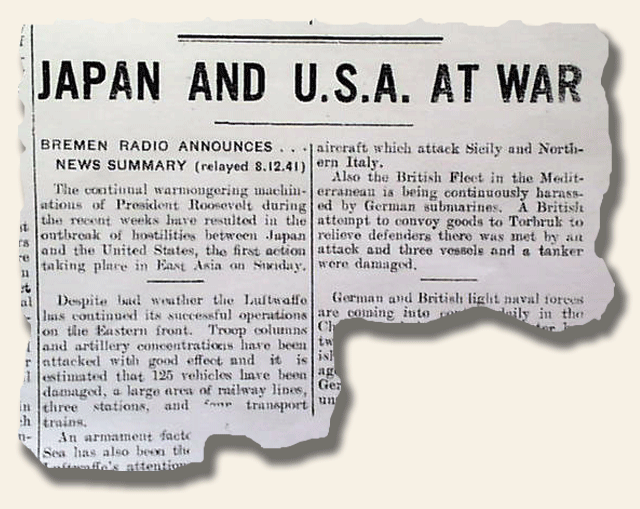
Why Hawaii Became the 50th State…
November 12, 2015 by GuyHeilenman · Leave a Comment
Authentic newspapers reporting Hawaii Statehood, especially those from Hawaii, have been sought by collectors for decades. The fascination for “all things Hawaii” appears to have no end in sight. It is with this in mind we bring to you the following guest-post from Francisco Meza:
Why Hawaii Became the 50th State
Hawaii, one of the tiniest states and the only one made up entirely of islands, formally became the 50th state in 1959 (August 21, 1959). But Hawaii’s story starts long before 1959. Polynesians, the earliest inhabitants of these islands, settled here over 1,000 years ago. British explorer Captain James Cook, in 1778, named them the Sandwich Islands. Fortunately, this name didn’t stick. Shortly thereafter, American traders made a beeline for Hawaii’s sandalwood. From July 7, 1898, Hawaiian Islands were an organized incorporated territory of the US.
Why did it Take So Long?
The genuinely interesting question about the Hawaiian Islands becoming a state is the reason it took so long. Over sixty years elapsed from the time Hawaii had become a US possession before it became the 50th state. There were several Hawaiian petitions for statehood in the early part of the 20th century. These petitions were either denied or ignored altogether. Some in the US had felt that the Hawaiian Islands had no natural connection with the remainder of the mainland US. Most obviously, Hawaii wasn’t a contiguous territory. It lay 2,000 miles from the US coast.
American Plantation Owners Resented Paying Import Taxes
The clout of the American plantation owners in Hawaii resulted in its annexation in 1898. The protection of the plantations owners’ financial interests played a huge part too. They were keen on gaining exemption from paying import taxes for the sugar that they shipped to the mainland US. The plantation owners also wanted to safeguard their large land holdings from possible confiscation or annexation under a renewed Hawaiian monarchy.
The US Administration and Citizens Didn’t Favor Annexation of Hawaii
The sentiment in the US about the annexation of the Hawaiian Islands was always strong. The people felt it’d be an imperialistic, unjust, and hence, a most un-American move. Hawaii wasn’t only about sugar. It was an important coaling station for naval vessels, as well as, a potential major harbor. In the 18th and 19th centuries, Great Britain, Russia, and Japan had pressured Hawaii for trade concessions.
The Reasons for the Delay
At the time of annexation (1898), the monarchy had been in existence for just about a century. Originally, the monarchy had leveraged the firepower of the European sailors to consolidate power. An element of brutality was involved too. A high percentage of Hawaii’s Caucasian residents had been there for so long that they considered themselves native. Additionally, numerous Chinese, Portuguese, and Japanese immigrants had come to Hawaii as agricultural laborers and settled down permanently.
Polynesian Hawaiians Wanted to Maintain the Status Quo Because They Considered the Sizable Japanese Populace in Hawaii a Threat to Polynesian Prosperity
The six-decade reluctance to alter Hawaii’s status from a US territory to state lay both within the Hawaiian Islands and the US mainland. In the mainland, it concerned the uncertainty and fear about permitting electoral authority to any one ethnic group. It wasn’t merely ethnically Polynesian versus Caucasian.
In the Hawaiian Islands, some ethnically Polynesian Hawaiians didn’t favor the change to a US state from the existing US territory. This is mainly because, although they were comfortable feeling almost “American” as long as Hawaii was a US territory, they were apprehensive that’d change in case Hawaii became a state. After WWII had ended, the occupation of Japan by the Allies fuelled their fears even more. The Polynesian Hawaiians’ fears originated from a belief that the Japanese populace on the Hawaiian Islands (almost as high as 30 percent) would, in the event of universal franchise that statehood authorized, organize and vote itself into leadership. And Polynesian Hawaiians considered that the Japanese ascent to Hawaii leadership would result in an overall Polynesian descent in Hawaii.
Factors that Favored Hawaii Becoming the 50th State
At the instant of the vote to statehood, almost 90 percent of Hawaii’s populace comprised US citizens. The importance of Hawaii in WWII had secured its identity as 100 percent American both in the minds of the mainlanders as well as the Hawaiians. Additionally, persistent and successful lobbying of Congressional representatives in the initial phase of the contemporary Civil Rights Movement swayed enough members of Congress into accepting the Hawaiian statehood. They were prepared to overlook the islands’ racial makeup.
Why Didn’t Guam or America Samoa Become a State Too?
Almost 18 years after the Pearl Harbor attack, Hawaii, considered a distant frontier of American settlement, was declared a US state in 1959. Since the 1820s, European Americans had settled down in Hawaii and established English as a language. Additionally, an American-style legal system had been introduced early on, and the US dollar was the main currency.
In the case of American Samoa, indigenous Samoans make up almost 90 percent of the population. Hence, it’s unlikely that American Samoa will ever become a US state. In the case of Guam, the indigenous Chamorros make up almost 37 percent of the population. The remainder includes Filipinos, Chinese, Whites, Japanese, Micronesians, Vietnamese, Koreans, and Indians. It’s highly unlikely that Guam will become a US state in the near future.
Summary
After WWII had ended, Hawaiians themselves desired US statehood. Even during the 14-year intervening period before Hawaii was formally conferred statehood, the “49th State” Record Label was immensely popular in the Hawaiian Islands. Eventually, Alaska became the 49th state at the beginning of 1959. Several months later, Hawaii became the 50th.
If you are ever in Hawaii and want to learn about Hawaiian culture, take a few Hawaii Tours that encompass Oahu and the other islands. You’ll learn see where the Hawaiian battles happened, see the beautiful nature, and stop by Pearl Harbor.
© Francisco Meza
Most Popular History’s Newsstand Posts – January 2023 update
February 3, 2023 by GuyHeilenman · Leave a Comment
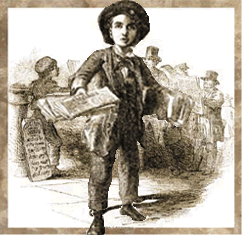 Whereas some posts are time-sensitive, others have staying power. Although the History Newsstand Blog (sponsored by RareNewspapers.com) has been operating for nearly 15 years and has thousands of entries, certain posts have consistently appeared in the “Top Ten Most Popular Posts” list shown on the right-side menu. The top half-dozen as of this post are:
Whereas some posts are time-sensitive, others have staying power. Although the History Newsstand Blog (sponsored by RareNewspapers.com) has been operating for nearly 15 years and has thousands of entries, certain posts have consistently appeared in the “Top Ten Most Popular Posts” list shown on the right-side menu. The top half-dozen as of this post are:
- Do Old and Antique Newspapers Have Any Collectible Value?
- Setting values for collectible newspapers…
- Genuine or reprint?
- Framing and Storing Newspapers… the ongoing story…
- More on printing newspapers in the 1700’s…
- More on printing newspapers in the 1700’s…
- The reprint issues of the “Honolulu Star-Bulletin” Pearl Harbor issue…
In regard to the most popular (Do Old and Antique Newspapers Have Any Collectible Value?), if you ever have an old newspaper and are curious as to its potential (approximate) value, please contact us directly (info@rarenewspapers.com) as we do not respond through the post itself.
Announcing: Catalog #327 for February, 2023 – Rare & Early Newspapers for collectors…
January 30, 2023 by GuyHeilenman · Leave a Comment
|
|
[The links above will redirect to the latest catalog in approx. 30 days
upon which time it will update to the most recent catalog.]
They put it in print, 1947 – The day Roswell became a boldfaced destination on the map…
September 12, 2022 by GuyHeilenman · Leave a Comment
With few exceptions, the most collectible/desirable “1st reports” of most major events are found in newspapers printed the day after the event occurred. However, it is hard not to ponder what people were reading in the newspapers printed on the “day of” such events. The reality that most memorable events in history took place on days in which the average person woke up to an ordinary, typical, “same-ol-same ol” world, poured themselves a cup of coffee, and sat down to read the relatively uneventful news reports reporting on the events from the prior day. What were people reading on the day of Lincoln’s assassination… the bombing of Pearl Harbor… the “twin-towers” attack… the sinking of the Titanic… the Hindenburg explosion… the 1906 San Francisco earthquake/fire… the (atomic) bombing of Hiroshima? In nearly every instance the newspapers printed and read on the day of such events including nothing whatsoever related to what was to come a mere hours later. How could they?
It is this common-sense reality which made our recent discovery of the Chicago Daily Tribune printed on the day of the “Roswell Incident” rather intriguing. See for yourself:
National Day of Prayer… Love our neighbors… Newspapers provide perspective…
May 5, 2022 by GuyHeilenman · Leave a Comment
As we reflect on the political, religious, racial, socio-economic, etc., etc., etc. diversity of the citizens of the United States on this National Day of Prayer, one cannot ignore what appears to be our ever-increasing polarization and wonder if our days are numbered. Is it possible to learn to appreciate our differences… to be kind… to play nice? When we were just sprouting, many of us were taught the Biblical mandate to love our neighbors – albeit a difficult task, at least we could wrap our minds around the concept.
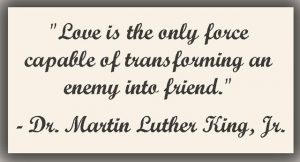 However, Jesus, in His famous Sermon on The Mount, upgraded this calling to a height eclipsing human reason:
However, Jesus, in His famous Sermon on The Mount, upgraded this calling to a height eclipsing human reason:
“You have heard the law that says, ‘Love your neighbor’ and hate your enemy. But I say, love your enemies! Pray for those who persecute you! In that way, you will be acting as true children of your Father in heaven. For He gives His sunlight to both the evil and the good, and He sends rain on the just and the unjust alike.”
Is this really possible? Can we actually learn to love those who violently oppose us – who would wish us harm? God tells us that with Him, ANYTHING is possible. He also provides considerable encouragement when He states: “You often do not have because you do not ask.”
Reading news from the day it was first reported through historical first-hand accounts as found in Rare & Early Newspapers provides incredible perspective. Our shared heritage was built upon diversity. Did we make mistakes, have passionate disagreements, and even come to the brink of our demise? Absolutely! However, through it all we managed to stay together – to be a melting pot unlike any the world had ever experienced. Was this… is this a God-thing? One thread woven throughout our history has been the calls by our leaders (Presidents, Governors, etc.) to seek God through prayer – often given as Proclamations for a Day of Thanksgiving, Humiliation, and Prayer. The truth is, prayer has been woven throughout the fabric of our nation from the start.
So, on this agreed upon, country-wide, National Day of Prayer…
Dear Lord,
We, as a nation, need Your help. Please give us the ability too see others through Your eyes and to love those with whom we fervently disagree. We understand the truth in President Lincoln’s words: “A house divided against itself cannot stand.” We realize there are many from outside our borders who are actively fomenting such division, and rather than steeling ourselves against such attacks, we too often respond as mere pawns. Help us to unite against such nefarious intentions. Help us to appreciate our common Source – that we are all made in Your image, our common citizenry, and the abundance of our shared experiences – birth, death, and a ton of joys and sorrows in between. Help us to play nicely with one another – to seek common ground whenever possible, and to agree to live peacefully with our differences. While humanly absurd, please give us Your strength to love one another. We grasp this is a You-size quest and therefore come to You with child-like humility – pleading for You to do that which we cannot do ourselves. We, as a nation, need Your help. Thanks in advance.
Amen
The following is a post from the past which, in my opinion, is worth a second look:
America – pulling a nation back together…
 My Fellow Americans: Devastating hurricanes, Pearl Harbor, 9-11, the end of WWII, Lindbergh’s 1st flight across the Atlantic – while there is much that divides us, there have been times throughout our history when both triumphs and tragedies have inspired us to lay down our weapons and to unite as one. While these times of mutual good will are typically short-lived, they often act as a reset to help center us on that which binds us together. We need such a time!
My Fellow Americans: Devastating hurricanes, Pearl Harbor, 9-11, the end of WWII, Lindbergh’s 1st flight across the Atlantic – while there is much that divides us, there have been times throughout our history when both triumphs and tragedies have inspired us to lay down our weapons and to unite as one. While these times of mutual good will are typically short-lived, they often act as a reset to help center us on that which binds us together. We need such a time!
It is was with the current atmosphere of angst as a backdrop that I was moved by an under-the-radar prayer found buried on page 11 of an issue reporting the assassination of President JFK. His death, airmailed via television directly into the living room of nearly every home in America, brought together Republicans, Democrats, and Independents alike and unified us around shared grief. May a day come when such unity of spirit flourishes without the inspiration of deep sorrow, tragedy, or war. As another assassinated President once said: “A house divided against itself cannot stand (Abraham Lincoln).” It is time for us to lay down our weapons. Much is at stake.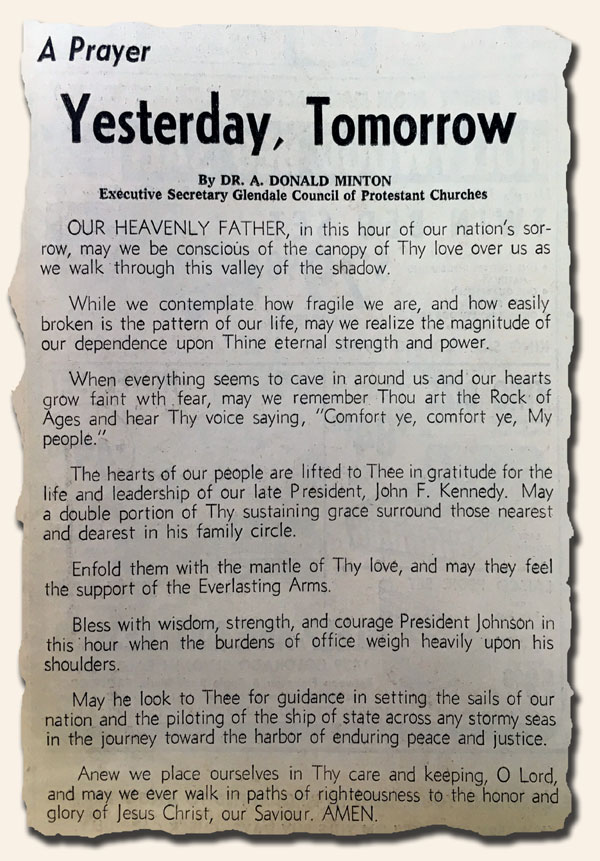
WW2 Era Newspapers Found In The Attic… Are They Worth Anything?
October 25, 2021 by GuyHeilenman · Leave a Comment
Perhaps the most common inquiry we receive concerns newspapers from World War II found in parents’ attics. As generations pass it is incumbent upon their children to sort out what is of value and what is not.
The list which follows is a guide for determining what to keep and what to dispose.
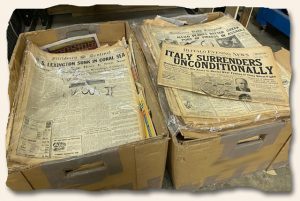 In general, there are only about 15 events which are sufficiently notable to excite most collectors. Those event not included on the list are considered “generic” or “atmosphere” issues which, although reporting much on the war, are generally not significant enough to draw the attention of the serious collector.
In general, there are only about 15 events which are sufficiently notable to excite most collectors. Those event not included on the list are considered “generic” or “atmosphere” issues which, although reporting much on the war, are generally not significant enough to draw the attention of the serious collector.
It’s worth noting that graphic appeal tends to trump title. Example: the New York Times remains one of the more notable newspapers of the 20th century, but their headlines were typically conservative, lacking any drama, flash, or graphic appeal. Small town newspapers with dramatic graphic appeal will be more desired.
Issues which fit the events and criteria noted below could well have collector value. Feel free to send the exact title and date of each along with photos of the entire front pages (showing margins) to: info@rarenewspapers.com
Note: Perhaps the mostly commonly reprinted issue of the war is the Honolulu Star-Bulletin of Dec. 7, 1941. Most of the issues on the market are the common reprint, still sold at the souvenir stand at the U.S.S. Arizona Memorial in Honolulu. See this blog post on how to tell a reprint from the genuine issue.
Top 15 events of World War II:
1) Germany invades Poland, 9/1/1939
* This event marked what many regard as the start of the war. Although not an American
event, most collectors want this report among their holdings.
2) Attack on Pearl Harbor, 12/7/1941
* Japan’s naval air force attacks military bases on Oahu, Hawaii, thus thrusting the United States into the war. The more dramatic and shocking the wording in a banner headline the better.
3) U.S. Declares war against Japan, 12/8/1941
* Just one day after the attack on Pearl Harbor the United States officially declares war against Japan, formalizing America’s entry in the war in the Pacific.
4) U.S. declares war against Germany & Italy, 12/11/1941
* The United States enters the war in Europe as well, just 3 days after declaring war against Japan.
5) Battle of Midway, 6/4-7/1942
* Just six months after Pearl Harbor the United States scores a major naval victory in the Pacific against Japan. Being a multi-day event, collectors would pursue the best headline near the end of the battle reporting the American victory.
6) D-Day, 6/6/1944
* With Axis forces controlling much of Western Europe, this day marks the offensive of the Allied forces in re-taking conquered countries. The word “Invasion” is desired somewhere within the headlines.
7) Battle of the Bulge, 12/16/1944
* This was the last major German offensive on the Western Front taking place from December 16, 1944 to January 25, 1945. Issues near the end of the battle which reported an Allied victory would be more desired.
8) Photo of the flag raising on Mt. Suribachi, Iwo Jima, 2/23/1945
* If there was a single, iconic photo of American successes in the Pacific it would be this Pulitzer Prize-winning photo. Many newspapers included it in their editions of a day or two later, many did not. Better if the photo is on the front page, as many newspapers—when using it—did so on an inside page.
9) Death of FDR, 4/12/1945
* Although arguably not a true war event, the death of the President who was Commander-In- Chief of the military through almost the entirety of the war cannot be missed as a notable event.
10) Death of Hitler, 4/30/1945
* Hitler’s suicide deep inside a Berlin bunker essentially ended the war in Europe as just days later terms of surrender were agreed to by Nazi officials. Most newspapers reported his death on May 2, and a few published the Nazi propaganda report that the Fuehrer: “…has fallen in battle at the head of the heroic defenders of the Reich capital…”. The blunt words: “Hitler Dead” are more dramatic than “Death of Hitler”.
11) V-E Day, 5/7/1945
* The official end of the War in Europe. This was one event where newspapers often used patriotic embellishments to celebrate the victory, some multi-colored, some incorporating war photos within letters, etc.
12) Atomic bomb drop on Hiroshima, 8/6/1945
* With the war in the Pacific still raging, the first atomic bomb ever deployed was dropped over the city of Hiroshima. Some newspaper down-played the horrific affects of the bomb. More desired are headlines which more accurately reported the incredible devastation.
13) Atomic bomb drop on Nagasaki, 8/9/1945
* Just 3 days after Hiroshima, the second atomic bomb was dropped, which prompted the Japanese to pursue surrender terms. Again, bluntly accurate reporting in the headline is desired over a more subdued report.
14) V-J Day, 8/15/1945
* Terms for surrender were agreed upon, and the world announced the end of World War II. Much like V-E Day, newspapers typically became very creative in patriotically celebrating the end of the war. The more creative the front page the better.
15) Formal surrender of Japan, ending WWII, 9/2/1945
* Signing of the surrender terms happened on board the U.S.S. Missouri in Tokyo Bay. Although most collectors would consider V-J Day as the end of the war, and in many respects it was, collectors often pursue this event as well.
There are also 2nd-tier items which could be collectible, but the extent of coverage and graphic appeal are paramount, and in some cases the title/publisher is essential. The list below contains such items, and will be updated from time-to-time.
Pre-War
Nuremberg Laws enacted, 9/15/1935
Jews no longer permitted to own property (various)
Opening of Concentration Camps (various)
Kristallnacht, 11/9-10/1938
During The War
Fake Report of attack on Los Angeles, “Battle of Los Angeles” (2/25/1942)
Bismarck Sunk, 5/27/2941
Star of David Badge, 9/7/1941
Doolittle Raid , 4/18-20/1942
USS Lexington Lost, 6/12/1942
Bataan Death March, 1/28/1944
JFK PT Boat, 6/11/1944
MacArthur returns to the Philippines, 10/20/1944
Post-War
USS Missouri – Peace Treaty Signed, 9/2/1945
Louis Zamperini Found, 9/9/1945
Patton’s Death, 12/21/1945




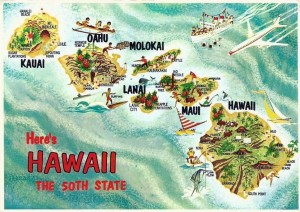
 February’s catalog (#327) is now available. Also shown below are links to a video featuring highlights from the catalog, our currently discounted newspapers, and recent posts to the History’s Newsstand Blog. Please enjoy.
February’s catalog (#327) is now available. Also shown below are links to a video featuring highlights from the catalog, our currently discounted newspapers, and recent posts to the History’s Newsstand Blog. Please enjoy.